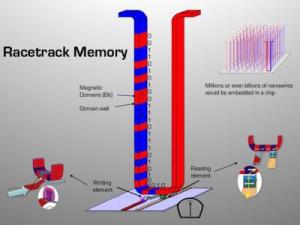Nov 16 2010
Annoyed by how long it took his computer to boot up, Kläui began to think about an alternative.
Hard disks are cheap and can store enormous quantities of data, but they are slow; every time a computer boots up, 2-3 minutes are lost while information is transferred from the hard disk into RAM (random access memory). The global cost in terms of lost productivity and energy consumption runs into the hundreds of millions of dollars a day.
 The bits of information stored in the wire are simply pushed around inside the tape using a spin polarized current, attaining the breakneck speed of several hundred meters per second in the process.
The bits of information stored in the wire are simply pushed around inside the tape using a spin polarized current, attaining the breakneck speed of several hundred meters per second in the process.
Like the tried and true VHS videocassette, the proposed solution involves data recorded on magnetic tape. But the similarity ends there; in this system the tape would be a nickel-iron nanowire, a million times smaller than the classic tape. And unlike a magnetic videotape, in this system nothing moves mechanically. The bits of information stored in the wire are simply pushed around inside the tape using a spin polarized current, attaining the breakneck speed of several hundred meters per second in the process. It's like reading an entire VHS cassette in less than a second.
In order for the idea to be feasible, each bit of information must be clearly separated from the next so that the data can be read reliably. This is achieved by using domain walls with magnetic vortices to delineate two adjacent bits. To estimate the maximum velocity at which the bits can be moved, Kläui and his colleagues* carried out measurements on vortices and found that the physical mechanism could allow for possible higher access speeds than expected. Their results were published online October 25, 2010, in the journal Physical Review Letters. Scientists at the Zurich Research Center of IBM (which is developing a racetrack memory) have confirmed the importance of the results in a Viewpoint article. Millions or even billions of nanowires would be embedded in a chip, providing enormous capacity on a shock-proof platform. A market-ready device could be available in as little as 5-7 years.
Racetrack memory promises to be a real breakthrough in data storage and retrieval. Racetrack-equipped computers would boot up instantly, and their information could be accessed 100,000 times more rapidly than with a traditional hard disk. They would also save energy. RAM needs to be powered every millionth of a second, so an idle computer consumes up to 300 mW just maintaining data in RAM. Because Racetrack memory doesn't have this constraint, energy consumption could be slashed by nearly a factor of 300, to a few mW while the memory is idle. It's an important consideration: computing and electronics currently consumes 6% of worldwide electricity, and is forecast to increase to 15% by 2025.
Source: http://www.epfl.ch/